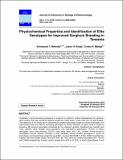Physiochemical Properties and Identification of Elite Genotypes for Improved Sorghum Breeding in Tanzania

View/
Date
2019-02-15Author
Mwenda, Emmanuel
Ringo, Justin
Mbega, Ernest
Metadata
Show full item recordAbstract
Variability in physiochemical properties in sorghum is critical in cultivar development for optimum grain quality and crop resistance against fungal and insect pests. These traits are not well studied. The objective of this study was to characterize sorghum genotypes based on kernel phenotypic and biochemical traits and identify promising genotypes for better utilization of these traits in sorghum breeding. 98 sorghum genotypes comprised by the released varieties, breeding lines, hybrids and local cultivars were studied using qualitative and quantitative parameters. 75.51% of these genotypes have thick pericarp, 33.67% have testa layer, and 7.0% showed mostly-corneous endosperm texture. Results revealed a wide variability among studied genotypes in terms of phenotypic and biochemical properties (p<0.001). A cross IES11038 X A1GD 34553 recorded the highest 100 seed weight (6.2g). Pato and IESV 92174DL were the hardest genotypes with 110.33 and 108.4N respectively. Protein content ranged from 6.52 to 12.23%, of which Naco Mtama 1 and IESV 24030SH were the promising genotypes. Genotypes ICSA 88006 x IESV92172DL, ICSA15 x R8602 and GADAM recorded the highest starch concentration (79 g/100g). The identified elite genotypes could enable selection and hybridization of useful traits.
URI
https://doi.org/10.9734/jabb/2018/v20i130067https://dspace.nm-aist.ac.tz/handle/20.500.12479/1936
